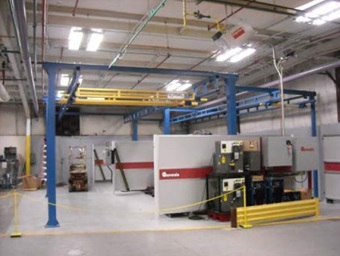Robots are cool. When I was little, robots seemed to only exist in cartoons and movies and Atari games. Now that I'm all grown up (more or less) and working in the manufacturing world, it's amazing to me to see all the different places where robotics are used. In this application, a combination of robotic welders and Gorbel cranes transformed a production process, simplifying it and making it safer.
The customer is a manufacturer of motorized recreational and industrial carts. In this work cell, a steel tube frame and a welding jig are used to form the cart frame. The final dimensions of the finished frame when lifted out of the jig are approximately 108” X 70” and 350lbs. The work cell is 40’ long x 30’ wide and the jig itself weighs 1000lbs.
The Problem:
Before the installation of new robotic welders, the cart frames were hand welded and the frame jigs were incorporated into a permanent steel table designed to handle one “model” or cart. Once the frames were complete they lifted them out of the jig with an archaic I beam style crane that was difficult to push and pull. Ergonomics and safety were a major concern when dealing with the 1000# frame jig.
The Solution:
The customer was a long time Gorbel user and chose a Gorbel Free Standing Work Station Crane with hoists and lifting slings. The runway length is 45’ and a conductor bar was used to eliminate festoon problems.
Two welding robots were installed side by side, separated by 20’. In order to service both welders, four bridges and two runway systems suspended by common headers were installed. Two of the bridges were designed to handle the completed frames that are lifted out of the jig and placed on frame carts, then rolled to the next manufacturing step. One “center” bridge was designed to handle the welding jigs for both robots.
They used a 4th bridge and a separate runway system on the “back” of the welding robots. The runways shared common headers and support structures. The 4th bridge was designed to load the robots with the wire welding material. This bridge was small, only 4’ wide, but it allowed multi-directional travel to easily load the wire / drum on the centerline of the robot wire in-feed.
 The Results:
The Results:
A 1000# steel weld jig is picked up off a storage rack with the Gorbel crane and the jig is placed into a robotic welding station. The weld jig is then loaded with various small sections of steel framing until the skeleton of the frame is complete. Once the jig is completely loaded, the robotic welder cycles through its program until the entire cart frame is welded. The welded frame is then unloaded from the jig and placed on a rolling cart that proceeds to the next step on the production line.
The new robotic station allows for multiple cart models to be manufactured in the same cell and the crane allows one employee to operate the process. The worker simply changes the jig in the robot when they need to build a new cart model. The customer now has the ability to manufacturer 5 different models in the same work cell. The old system would require 5 work cells. The workers like the simple design and functionality of the new system. There is less worker fatigue and the work cells are safer.